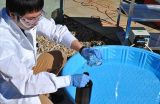(Press-News.org) Taste strongly influences food and beverage intake, including alcohol. Furthermore, genetic variation in chemosensory genes can explain variability in individual perception of and preference for alcoholic drinks. A new study has examined the relationship between variation in alcohol-related sensations and polymorphisms in bitter taste receptors genes previously linked to alcohol intake, and for the first time, polymorphisms in a burn receptor gene. The findings indicate that genetic variations in taste receptors influence intensity perceptions.
Results will be published in the October 2014 online-only issue of Alcoholism: Clinical & Experimental Research and are currently available at Early View.
"People may differ in the sensations they experience from a food or beverage," explained John E. Hayes, assistant professor of food science as well as director of the Sensory Evaluation Center at The Pennsylvania State University. "And like color blindness, these perceptual differences have a biological basis. Prior work shows that some people experience more bitterness and less sweetness from alcoholic beverages like beer. In general, greater bitterness relates to lower liking, and because we generally tend to avoid eating or drinking things we don't like, lower liking for alcohol beverages associates with lower intake." Hayes is also the corresponding author for the study.
"The link between genetic variations in receptors and taste is an area of growing importance," noted Russell Keast, a professor of sensory and food sciences at Deakin University in Australia. "Variations in bitter taste may be particularly important because previous research has shown people who experience bitterness as more intense consume less bitter vegetables. However, it does get more complex because alcoholic beverages contain flavours and tastes that may mask any aversive effects of bitterness – for example, the sweetness of a sherry, or the aromas of a cocktail."
"We picked the two bitter receptor genes – taste receptors type 2 member 13 (TAS2R13) and type 2 member 38 (TAS2R38) because both had previously been linked to differential alcohol intake," said Hayes. "In contrast, variation in the burn receptor gene – transient receptor potential vanilloid receptor 1(TRPV1) – has not previously been linked to differences in intake, but we reasoned that this gene might be important as alcohol causes burning sensations in addition to bitterness."
Hayes and his colleagues genotyped 93 Caucasian participants (58 women, 35 men), 18 to 45 years of age, for 16 single nucleotide polymorphisms (SNPs) – a DNA sequence variation occurring commonly within a population – in TRPV1, three SNPs in TAS2R38, and one SNP in TAS2R13. Participants then rated alcohol samples presented in two ways: one, a 16-percent alcohol whole-mouth, sip-and-spit solution with a single time-point rating of overall intensity; and two, a cotton swab saturated with 50 percent alcohol and placed on the back of the tongue, with repeated ratings made during three minutes.
"Ours is the first study to show that the sensations from sampled alcohol vary as a function of genetics," said Hayes. "The present data are wholly consistent with prior speculation that taste-gene variants and alcohol intake are associated due to perceptual differences that influence liking. Our study was also the first to consider whether variation in the burn receptor gene TRPV1 might influence alcohol sensations, which has not previously been linked to alcohol intake. More specifically, we showed that when people taste alcohol in the laboratory, the amount of bitterness they experience differs, and these differences are related to which version of a bitter receptor gene the individual has. We also found that burning sensations may likewise differ with different versions of TRPV1."
"While the identification of SNPs associated with bitterness of alcohol is the key finding," said Keast, "the potential implications regarding excess alcohol consumption are perhaps more important. However, those implications may be difficult to disentangle given the complexity of behaviours associated with dietary intake. Evidence is slowly emerging that taste receptor variation may influence dietary intake. While this was not assessed in the current study, the implications are that a person who finds a food particularly bitter will dislike that food and not consume it. Therefore this study provides some insight into a possible reason why some people may avoid alcohol."
Hayes agreed. "People differ in their food sensations and this influences what we like," he said. "That is, not everyone starts from the same blank slate when it comes time to learn to like a specific food or beverage. Accordingly, it may be easier for some people to learn to like to eat or drink a certain food and beverage, including alcohol. However, other factors such as learning, prior experience, and the environment also play a huge role in our preferences and the choices we make."
Hayes added that it is unlikely that chemosensory variation plays a role in predicting alcohol intake once an individual becomes dependent. "However, genetic variation in chemosensation may be underappreciated as a risk factor when an individual is initially exposed to alcohol, and is still learning to consume alcohol," he said. "Some have suggested taste genes may act like as a 'stage gate' on other genetic risk factors; if you never ingest alcohol in the first place because of the taste, metabolic or reward related polymorphisms may be largely irrelevant."
"Thus, the next logical step would be to look at the genetic variations and assess if these alleles predict differences in liking," said Keast.
Nonetheless, both Hayes and Keast noted that genetics does not wholly determine one's drinking fate.
"Biology is not destiny," said Hayes. "That is, food choice remains that, a choice. Some individuals may learn to overcome their innate aversions to bitterness and consume excessive amounts of alcohol, while others who do not experience heightened bitterness may still choose not to consume alcohol for myriad reasons unrelated to taste."
"Just because a genetic variant in a taste receptor is associated with perceived intensity does not mean any more than the two variables are associated," added Keast. "The broader implications come from the thought that bitterness or pungency will influence intake – this may or may not be true. Future research can assess if the variants are linked with intake."
INFORMATION:
Alcoholism: Clinical & Experimental Research
Contact: John E. Hayes, Ph.D.
jeh40@psu.edu
814.863.7129
The Pennsylvania State University
Add'l contact: Russell Keast, Ph.D.
russell.keast@deakin.edu.au
61.3.9244.6944 (Australia)
Deakin University
Alcoholism: Clinical & Experimental Research (ACER) is the official journal of the Research Society on Alcoholism and the International Society for Biomedical Research on Alcoholism. Co-authors of the ACER paper, "Polymorphisms in TRPV1 and TAS2Rs associate with sensations from sampled ethanol," were: Alissa L. Allen of the Sensory Evaluation Center, and the Department of Food Science, in the College of Agricultural Sciences at Pennsylvania State University; and John E. McGeary of the Providence Veterans Affairs Medical Center in Providence Rhode Island, the Division of Behavior Genetics at Rhode Island Hospital, and the Center for Alcohol and Addiction Studies at Brown University. The study was funded by the National Institutes of Health. This release is supported by the Addiction Technology Transfer Center Network at http://www.ATTCnetwork.org.
Alcohol-evoked drinking sensations differ among people as a function of genetic variation
2014-09-23
ELSE PRESS RELEASES FROM THIS DATE:
Rate of diabetes in US may be leveling off
2014-09-23
Following a doubling of the incidence and prevalence of diabetes in the U.S. from 1990-2008, new data suggest a plateauing of the rate between 2008 and 2012 for adults, however the incidence continued to increase in Hispanic and non-Hispanic black adults, according to a study in the September 24 issue of JAMA.
Although there has been an increase in the prevalence and incidence of diabetes in the United States in recent decades, no studies have systematically examined long-term, national trends of this disease, according to background information in the article.
Linda ...
Effect of intervention, removal of costs, on prenatal genetic testing
2014-09-23
An intervention for pregnant women that included a computerized, interactive decision-support guide regarding prenatal genetic testing, and no cost for testing, resulted in less prenatal test use and more informed choices, according to a study in the September 24 issue of JAMA.
Since the introduction of amniocentesis, prenatal genetic testing guidelines have focused on identifying women at increased risk of giving birth to an infant with Down syndrome or other chromosomal abnormalities, for whom invasive diagnostic testing should be recommended. Prenatal genetic testing ...
Lung cancer test less effective in areas where infectious lung disease is more common
2014-09-23
An analysis of 70 studies finds that use of the diagnostic imaging procedure of fludeoxyglucose F18 (FDG)-positron emission tomography (PET) combined with computed tomography (CT) may not reliably distinguish benign disease from lung cancer in populations with endemic (high prevalence) infectious lung disease compared with nonendemic regions, according to a study in the September 24 issue of JAMA.
Depending on the risk for cancer, diagnostic guidelines suggest or recommend FDG combined with PET as a noninvasive test to assess the risk of cancer or benign disease, according ...
Study questions accuracy of lung cancer screens in some geographic regions
2014-09-23
A new analysis of published studies found that FDG-PET technology is less accurate in diagnosing lung cancer versus benign disease in regions where infections like histoplasmosis or tuberculosis are common. Misdiagnosis of lung lesions suspicious for cancer could lead to unnecessary tests and surgeries for patients, with additional potential complications and mortality.
Histoplasmosis and other fungal diseases are linked to fungi that are often concentrated in bird droppings and are found in soils.
The study by investigators at Vanderbilt University and the Tennessee ...
Asteroid named for University of Utah makes public debut
2014-09-23
SALT LAKE CITY, Sept. 23, 2014 – What's rocky, about a mile wide, orbits between Mars and Jupiter and poses no threat to Earth?
An asteroid named "Univofutah" after the University of Utah.
Discovered on Sept. 8, 2008, by longtime Utah astronomy educator Patrick Wiggins, the asteroid also known as 391795 (2008 RV77) this month was renamed Univofutah by the International Astronomical Union's Minor Planet Center in Cambridge, Massachusetts.
"It's neat," Wiggins says. "There aren't too many other universities on the whole planet with asteroids named after them. So that ...
Does size matter? MRI imaging sheds light on athletes most at risk for severe knee injury
2014-09-23
The successful rise and fall of an athlete's moving body relies on an orchestrated response of bones, joints, ligaments and tendons, putting the many angles and intersecting planes – literally the geometry – of a critical part like a knee joint to the test. But it's more than just a footfall error at the root of one of the most devastating of sports injuries: the ACL or anterior cruciate ligament tear. In fact, size – of the femoral notch that sits at the center of the knee joint – and volume of the ACL combine to influence the risk of suffering a noncontact ACL injury. ...
Infant cooing, babbling linked to hearing ability, MU researcher finds
2014-09-23
COLUMBIA, Mo. – Infants' vocalizations throughout the first year follow a set of predictable steps from crying and cooing to forming syllables and first words. However, previous research had not addressed how the amount of vocalizations may differ between hearing and deaf infants. Now, University of Missouri research shows that infant vocalizations are primarily motivated by infants' ability to hear their own babbling. Additionally, infants with profound hearing loss who received cochlear implants to help correct their hearing soon reached the vocalization levels of their ...
Solar energy-driven process could revolutionize oil sands tailings reclamation
2014-09-23
Edmonton—Cleaning up oil sands tailings has just gotten a lot greener thanks to a novel technique developed by University of Alberta civil engineering professors that uses solar energy to accelerate tailings pond reclamation efforts by industry.
Instead of using UV lamps as a light source to treat oil sands process affected water (OSPW) retained in tailings ponds, professors Mohamed Gamal El-Din and James Bolton have found that using the sunlight as a renewable energy source treats the wastewater just as efficiently but at a much lower cost.
"We know it works, so now ...
Antifreeze proteins in Antarctic fish prevent both freezing and melting
2014-09-23
Antarctic fish that manufacture their own "antifreeze" proteins to survive in the icy Southern Ocean also suffer an unfortunate side effect, researchers funded by the National Science Foundation (NSF) report: The protein-bound ice crystals that accumulate inside their bodies resist melting even when temperatures warm.
"We discovered what appears to be an undesirable consequence of the evolution of antifreeze proteins in Antarctic notothenioid fish," said University of Oregon doctoral student Paul Cziko, who led the research with University of Illinois animal biology ...
NYU-Mount Sinai Beth Israel study explores drug users' opinions on genetic testing
2014-09-23
Genomic medicine is rapidly developing, bringing with its advances promises of individualized genetic information to tailor and optimize prevention and treatment interventions. Genetic tests are already guiding treatments of the human immunodeficiency virus (HIV) and hepatitis c virus (HPC), and emerging research is showing genetic variants may be used to screen for an individual's susceptibility to addiction to a substance, and even inform treatments for addiction.
While there appear to be many benefits inherent in the development of this field and related research, ...


